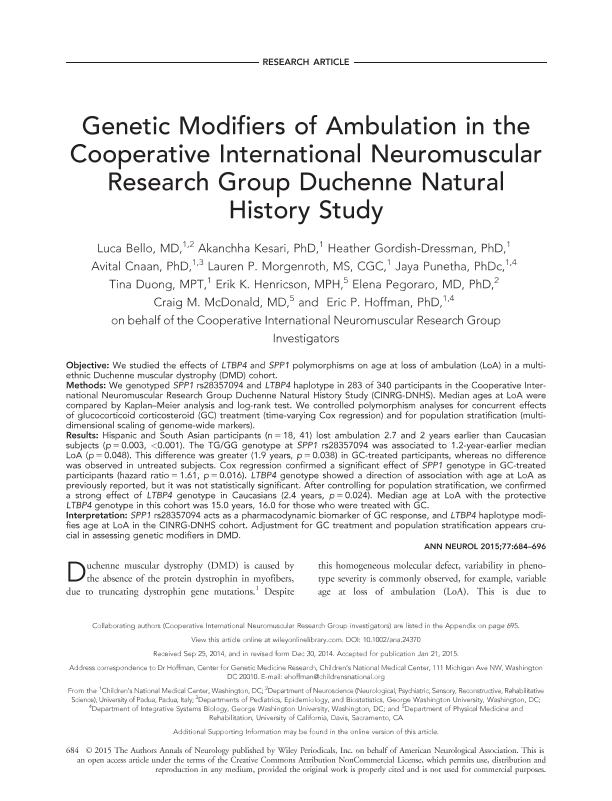Artículo
Genetic modifiers of ambulation in the cooperative international Neuromuscular Research Group Duchenne natural history study
Bello, Luca; Kesari, Akanchha; Gordish Dressman, Heather; Cnaan, Avital; Morgenroth, Lauren P.; Punetha, Jaya; Duong, Tina; Henricson, Erik K.; Pegoraro, Elena; McDonald, Craig M.; Hoffman, Eric P.; Dubrovsky, Alberto; Andreone, Luz ; Cooperative International Neuromuscular Research Group Investigators
; Cooperative International Neuromuscular Research Group Investigators
 ; Cooperative International Neuromuscular Research Group Investigators
; Cooperative International Neuromuscular Research Group Investigators
Fecha de publicación:
04/2015
Editorial:
Wiley-liss, Div John Wiley & Sons Inc
Revista:
Annals Of Neurology
ISSN:
0364-5134
e-ISSN:
1531-8249
Idioma:
Inglés
Tipo de recurso:
Artículo publicado
Clasificación temática:
Resumen
OBJECTIVE: We studied the effects of LTBP4 and SPP1 polymorphisms on age at loss of ambulation (LoA) in a multiethnic Duchenne muscular dystrophy (DMD) cohort. METHODS: We genotyped SPP1 rs28357094 and LTBP4 haplotype in 283 of 340 participants in the Cooperative International Neuromuscular Research Group Duchenne Natural History Study (CINRG-DNHS). Median ages at LoA were compared by Kaplan-Meier analysis and log-rank test. We controlled polymorphism analyses for concurrent effects of glucocorticoid corticosteroid (GC) treatment (time-varying Cox regression) and for population stratification (multidimensional scaling of genome-wide markers). RESULTS: Hispanic and South Asian participants (n=18, 41) lost ambulation 2.7 and 2 years earlier than Caucasian subjects (p=0.003, <0.001). The TG/GG genotype at SPP1 rs28357094 was associated to 1.2-year-earlier median LoA (p=0.048). This difference was greater (1.9 years, p=0.038) in GC-treated participants, whereas no difference was observed in untreated subjects. Cox regression confirmed a significant effect of SPP1 genotype in GC-treated participants (hazard ratio = 1.61, p=0.016). LTBP4 genotype showed a direction of association with age at LoA as previously reported, but it was not statistically significant. After controlling for population stratification, we confirmed a strong effect of LTBP4 genotype in Caucasians (2.4 years, p =0.024). Median age at LoA with the protective LTBP4 genotype in this cohort was 15.0 years, 16.0 for those who were treated with GC. INTERPRETATION: SPP1 rs28357094 acts as a pharmacodynamic biomarker of GC response, and LTBP4 haplotype modifies age at LoA in the CINRG-DNHS cohort. Adjustment for GC treatment and population stratification appears crucial in assessing genetic modifiers in DMD
Palabras clave:
Duchenne Muscular Dystrophy
,
Polymorphism
,
Ambulation
Archivos asociados
Licencia
Identificadores
Colecciones
Articulos(IBIOBA - MPSP)
Articulos de INST. D/INV.EN BIOMED.DE BS AS-CONICET-INST. PARTNER SOCIEDAD MAX PLANCK
Articulos de INST. D/INV.EN BIOMED.DE BS AS-CONICET-INST. PARTNER SOCIEDAD MAX PLANCK
Citación
Bello, Luca; Kesari, Akanchha; Gordish Dressman, Heather; Cnaan, Avital; Morgenroth, Lauren P.; et al.; Genetic modifiers of ambulation in the cooperative international Neuromuscular Research Group Duchenne natural history study; Wiley-liss, Div John Wiley & Sons Inc; Annals Of Neurology; 77; 4; 4-2015; 684-696
Compartir
Altmétricas



